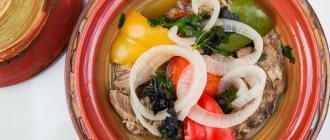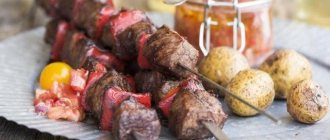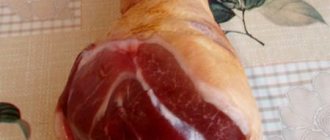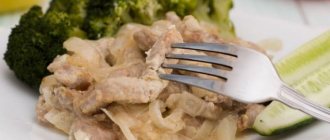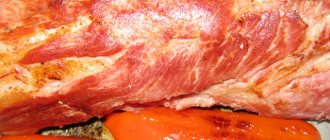What is "lagman"?
The name of this dish is a corruption of the Dungan word “lyumyan”, the interlinear translation of which means nothing more than “stretched dough”. The name reflects the basis of lagman - noodles, rolled out and stretched by hand. The noodles are usually served with a thick meat or vegetable sauce or broth with additives. As a rule, lamb or beef is used in the sauce (since the dish was originally Muslim, pork was considered an unacceptable addition). Vegetables and seasonings are limited only by the imagination and capabilities of the cook. By the way, the Uighurs have more than 180 recipes for how to cook lagman at home or over a fire!
DIY beef lagman noodles
Each beef lagman recipe contains noodles, which can be easily prepared at home.
To do this we take:
- premium flour – 0.5 kg;
- 3 yolks;
- warm water – 1 glass;
- salt;
- a little olive oil.
Combine all products and knead into a stiff dough. Knead for a long time. After the dough has formed a lump, it is coated with oil and placed in polyethylene for 40 minutes.
Roll out the ball on the table, cut into strips 0.5 cm wide. Form long noodles from each strip, greasing them with oil. The finished products are boiled in salted water for 8 minutes and drained in a colander. The cooked noodles are placed on the bottom of a serving plate, after which the frying and gravy are added.
The right dishes are the key to good luck
Before you cook lagman at home, you need to choose the right dishes - the quality of the prepared food depends on this. Basic conditions: the dishes must be wide (in this case, the moisture evaporates faster, and the vegetables are not stewed, but fried), with a thick bottom and walls - this is necessary for uniform heating of the dish and to prevent burning. The best option for cooking utensils is a cauldron, but if it is not available, you can use a wide and tall pan with a thick bottom, preferably cast iron.
Dough is important
Because “preparing lagman correctly” is identical to “preparing noodles correctly,” you need to remember the following: the noodles are pulled out exclusively by hand, and therefore the dough should be as elastic as possible. Long experience and many proven recipes have shown that the best option is the following: for half a kilogram of premium wheat flour, take the same amount of 2nd grade flour from durum wheat, rich in gluten. This amount of flour takes about a glass of water, 3 eggs, 1 small spoon of vinegar, add salt to taste. Vinegar gives the dough greater flexibility, but there are many recipes in which vinegar is not recommended.
Flour is poured into a deep bowl in a heap, a small depression is made in it, lukewarm water and beaten eggs are poured into it. The dough is thoroughly kneaded and kneaded, trying to avoid adding excess flour, until complete homogeneity and plasticity of the substance is achieved. It should be noted that the kneading process is difficult, but very important: the more elastic and durable the dough, the easier it is to pull the noodles out of it. Roll the finished mass into a ball, wrap it in a clean towel or cling film and put it in a cool place for 30-50 minutes.
Noodles
The slightly chilled dough is divided into pieces, rolled into thick ropes, thoroughly greased with any vegetable oil and left to rest for 15 minutes. Then each tourniquet is stretched, carefully rolling between the palms and avoiding tears. Then each strip of dough is folded in half and stretched by hand. Stretched strands should be regularly lubricated with vegetable oil; when stretching, periodically lightly hit the table - this helps stretch the noodles and prevents them from tearing. Folding and stretching is repeated until a skein of thin and long noodles is formed. This process takes practice, so don't be discouraged if the noodles don't turn out the way you wanted the first time. As a last resort, homemade noodles can be replaced with ready-made spaghetti, but you need to choose large ones and the best quality.
Cook the finished noodles immediately by carefully lowering them into very boiling water for 5 minutes. Do not stir the noodles as this will cause them to become tangled and sticky. Place the cooked noodles in a colander, rinse with plenty of running cold water, place in a deep bowl and thoroughly grease with vegetable oil. By the way, in Central Asia such noodles for lagman are called “chuzma”.
Lagman recipe in Uzbek at home
One of the simplest is the traditional recipe for lagman in Uzbek. It is prepared from:
Initially, you need to prepare the dough for the lagman. Large quantities of eggs are used for this purpose. To prepare the dough, you need to pour flour into a container, break eggs into it and add salt. In order for the noodles to roll out well, oil is added to it. The dough is kneaded until a homogeneous consistency is obtained. While kneading the dough, you need to add a small amount of water, which will ensure its elasticity. The test must be allowed to sit for half an hour. To prevent it from weathering, it is necessary to wrap it in plastic wrap.
Then the beef is washed and cut into small pieces. After this, the meat must be salted and peppered. The next step is to clean the bell pepper and cut it into strips. Carrots must be cut according to the same principle. There is no need to peel the tomatoes. They are simply cut into cubes.
Learn how to cook lagman using 6 secrets of oriental cuisine
Find out how to cook lamb lagman in this article.
The recipe for beef lagman at home requires the addition of tomatoes, which are pre-cut into cubes. After a sufficient amount of liquid appears in the cauldron, turnips, bell peppers and green beans are added to it. At the last stage, you need to add cabbage to the cauldron and simmer. The dish must be salted and peppered to taste.
During this period, you need to cook the noodles and drain them in a colander. Next it is transferred to plates. Place gravy with meat on top of the noodles.
Preparing lagman is a fairly simple process that requires absolutely all points to be completed.
How to cook lagman at home from beef and lamb
This recipe came from China: you need to take 350 g of beef and lamb, rinse well, dry with paper towels, cut into small cubes, put in a cauldron with heated vegetable oil and fry until golden brown. Mix finely chopped 300 g of green onions, 200 g of wild garlic stalks and 10 cloves of garlic and add to the meat. Fry the mixture of meat and vegetables for a couple more minutes, then add ground red pepper, spices of your choice and taste and 2 large spoons of tomato paste. Pour in two glasses of meat broth and simmer covered over low heat until cooked.
Place the finished noodles in a deep bowl, pour over the prepared sauce, sprinkle with finely chopped herbs and garlic. You can serve lagman with a salad of tomatoes, radishes and sweet bell peppers.
Chicken lagman
As a rule, this dish should be prepared from lamb. But not everyone loves it and not everyone has the opportunity to get lamb.
There is a way out, try making lagman from chicken meat. It is always available and inexpensive, and the taste is almost worse.
Ingredients.
- 800 grams of chicken meat.
- 250-300 noodles.
- 1 onion.
- 1 carrot.
- 3-4 cloves of garlic.
- 1 bell pepper.
- 2-3 tomatoes or a tablespoon of tomato paste.
- 1 teaspoon dry adjika.
- Sweet dry paprika.
- Vegetable oil.
- Salt and pepper to taste.
Cooking process.
The recipe for making chicken lagman is described very simply. So if something is not clear, look at the recipes above, everything is described step by step and in great detail.
1. And so cut the meat into pieces and fry with onions and carrots.
2. Add water and simmer until all the water is gone.
3. Next, add chopped bell pepper and garlic.
4. Fry vegetables with meat for 3-4 minutes.
5. Add spices, tomato paste, adjika, water, cover with a lid and simmer for 25-30 minutes on low heat.
6. Cook the noodles until done. Drain the water and season with butter.
7. Place the noodles on a beautiful deep dish and spread the sauce on top.
8. Before serving, garnish with chopped herbs.
Bon appetit.
Lagman for vegetarians
There is also a purely vegetable lagman. The recipe at home is easy to implement, and the result is fragrant and tasty: in a cauldron in heated vegetable oil, fry two chopped onions until golden brown, add two large sweet peppers cut into strips and fry for another 3 minutes. Then add diced potatoes (about 400 g) and fry until lightly browned along with vegetables. Next, add 100 g of soy sprouts, 4 large tomatoes cut into slices and fry for another 5 minutes. Then you need to pour a glass of water into the cauldron, add chopped garlic, spices of your choice, salt and simmer until tender. The main thing is that the potatoes are not boiled. Noodles in a deep plate are thickly poured with the prepared sauce and sprinkled with herbs.
Uyghur lagman with beans
Uighur lagman occupies a place of honor in the countries of Central Asia; this recipe is no less popular in Russia. The good thing about this dish for housewives is that its ingredients can be changed at your discretion.
The peculiarity of this particular recipe is that there is no gravy in it: only the juice of meat and vegetables, and besides, everything is simply fried and not stewed
Ingredients:
- beef – 0.8 kg;
- sweet pepper – 3 pcs.;
- green beans – 3 pcs.;
- green radish;
- onion – 5 heads;
- carrots – 2 pcs.;
- garlic – 7 cloves;
- tomatoes – 2 pcs.;
- tomato paste – 3 tbsp. l.;
- ready-made noodles;
- salt;
- meat broth - 0.5 l.
Of the spices, it is recommended to add only ground coriander - 2 tsp.
View this post on Instagram
17 Jan 2020 at 6:52 PST
Step-by-step recipe for making lagman at home:
- We cut the meat into thin slices, so it is better that it is slightly frozen initially.
- Remove the skins from the tomatoes; to do this, scald them with boiling water. Cut the tomatoes into 6 parts.
- Wash the rest of the vegetables, peel if necessary and cut into small cubes, and pass the garlic through a press.
- Place beef and onions into a hot cast iron or cauldron with oil and fry until slightly golden brown.
- Add carrots, tomatoes, radishes, garlic, pour in tomato paste diluted in 0.5 glass of water. Fry the vegetables for another 15 minutes.
- Now you can add the beans and fry for 7 minutes, stirring constantly.
- Pour the broth into the meat and vegetables and simmer everything over low heat for 30 minutes.
- Boil the noodles just before serving, drain the water and place in a flat dish.
Fried lagman should be served in portioned deep plates, into which the noodles are laid out and filled with meat and vegetable gravy.
View this post on Instagram
9 Jan 2020 at 2:31 PST
Uzbek lagman
How to cook delicious lagman in Uzbek? For 400 g of lamb and half a kilogram of homemade noodles you will need 1 sweet bell pepper; carrots, potatoes, onions - 2 pieces each, herbs, ground black pepper, salt, vegetable oil and 2 cloves of garlic. The noodles should already be prepared for cooking. And now, actually, how to cook lagman (step-by-step recipe):
- Boil the noodles until tender in plenty of water (without breaking them!).
- Finely chop the meat.
- Chop onions, carrots, sweet peppers and potatoes into small cubes.
- Crush or chop the garlic very finely.
- Heat oil in a cauldron or thick-bottomed pan and fry the meat until cooked.
- Add onion, mix it with meat and lightly fry.
- Add the remaining vegetables along with the garlic and fry, stirring regularly.
- Pour water so that all the products are covered with it, add salt and pepper, and simmer until done.
Classic beef lagman recipe
Preparing this delicious dish is not difficult, and the taste will conquer any gourmet.
In the classic version, the dish is prepared based on:
- beef meat – 500 g;
- potatoes - 5-7 tubers;
- carrots - 3 medium-sized root vegetables;
- tomato – 8 pcs.;
- sweet pepper – 3 pcs.;
- cumin – level teaspoon;
- bay leaves - a couple of pieces;
- hot ground pepper – 0.5 tsp;
- hops-suneli – 1 tsp;
- salt.
The classic lagman recipe will help you prepare a dish that is closer to the traditional one, without any innovations. On the stove in a cast iron cauldron or deep frying pan, you need to heat the sunflower oil well. When it reaches the desired temperature, you should dip the meat into it, cut into neat squares and fry until golden brown. You can lightly salt the meat product, simmer for a few minutes under the lid and add chopped onion. You need to simmer the meat and onions for about 8 minutes under the lid, then add the diced carrots and potatoes. Simmer for about 20 minutes.
Next are fresh diced tomatoes and bell peppers. All products are poured with broth (you can use boiled water) and when the liquid starts to boil, you need to pour in the spices, cover with a lid and cook for 30 minutes. 12 minutes before the end of cooking, add chopped garlic cloves and boil the noodles. You can buy store-bought noodles or make your own.
Serve the dish as follows - put some noodles on a plate, vegetables and meat on top. All this is poured with broth and served to the table.
Lagman and multicooker
There are recipes on how to cook lagman at home using a multicooker. For this you will need 650 g of beef, 4 potato tubers, 2 onions; carrots, tomato, bell pepper, daikon (or Margelan radish) - 1 piece each, 2 tablespoons of tomato paste, 3 cloves of garlic, a bunch of wild garlic, salt, peppercorns, vegetable oil. Meat and vegetables need to be chopped and fried in a multicooker in the “Frying” or “Baking” mode without closing the lid. First, the meat is fried, then, at intervals of 2-3 minutes, onions, carrots, radishes, peppers, wild garlic and tomatoes are added (in that order). Add a little water, close the multicooker lid, and set the “Stew” mode. Pressed garlic is added when the sauce is ready.
Lagman in a slow cooker recipe with step-by-step photos
The third and last recipe we will have is lagman in a slow cooker.
To prepare you will need:
- pork or beef pulp 400 - 500 g
- potatoes 3 pcs.
- onions 2 pcs.
- bell pepper 2 pcs.
- carrots 1 pc.
- celery root 0.5 pieces
- garlic 3 - 5 cloves
- dill, parsley, cilantro.
- Tomato paste 2 tablespoons
- Jeera or curry spices, black peppercorns, salt
- lagman noodles (spaghetti)
Let's start cooking:
- Wash the meat under running, cold water and cut into cubes. The quality of the meat determines how tasty and rich our lagman will turn out in a slow cooker. I recommend purchasing beef from reputable butchers, as I did.
- For convenience, onions should be taken in large sizes. Carefully peel it and dip it in water, and after a while cut it into half rings.
TIP: When chopping onions, use a glass of water. The more often you dip your knife blade in water, the less onion vapor will get into your eyes.
- The original recipe calls for radish, but I didn’t have any in the refrigerator, so I used celery root. We wash it well, peel it and cut it into cubes measuring 0.5 by 4 cm.
- We also cut the carrots into small cubes. To make it easier to peel carrots, you can use a vegetable peeler.
- We peel the potatoes and, like the carrots, cut them into cubes.
- Take a bell pepper, remove the stem, cut it into halves, and remove the seeds. We cut it in the same way. It is better to buy vegetables at the market. Preferably from grandmothers, as they are more likely to purchase a fresh and healthy product.
Let's move on to preparing the lagman dish:
- Pour a small amount of sunflower oil into the multicooker bowl. Both refined and unrefined flavored ones are suitable here.
- Place the meat evenly on the bottom of the bowl. We set the frying program for 20 - 30 minutes and fry until the excess moisture evaporates.
- Add onions and carrots to the meat and stir occasionally. Fry the meat with vegetables, when the onion becomes transparent, end the “frying” program.
- Place celery, potatoes, bell pepper into the multicooker bowl and mix. After a few minutes, salt the dish.
- Add turmeric, black peppercorns and cumin.
- Pass the garlic through a garlic press and add tomato paste.
- Pour enough water to hide the food, or more if you like your lagman thinner. You can use the broth in which the noodles were cooked.
- Close the lid of the multicooker, set the “stewing” program and the cooking time for one and a half hours. We prepare until the end of the program.
- While the vegetables and meat are being prepared, boil the spaghetti.
- Finely chop parsley, dill, cilantro. At the end of the stewing program, place the greens in the multicooker bowl. You can use dry herbs, or fresh ones when serving.
- Place spaghetti on a plate and add stewed vegetables and meat.
Lagman is ready, bon appetit!
Ramen
This is a very unusual and tasty option for how to cook delicious lagman in Japanese (in Japan it is called “ramen”).
In a properly selected bowl, heat the vegetable oil, fry finely chopped 2 onions until golden brown, add 2 carrots cut into strips and fry for another 5-7 minutes. You need to mix carefully so that the carrot strips do not break. In a separate bowl, fry 300 g of lean (!) pork, previously cut into long slices and marinated in soy-garlic sauce. Then combine the vegetables and pork and heat in the mixture for 3 minutes. In a separate saucepan, boil 1 liter of broth, pour into it 5 large spoons of soy sauce or a couple of spoons of dry meat mixture.
Lightly fry the boiled noodles in vegetable oil, place in a deep plate, and top with meat and vegetables; pour in the broth and serve with finely chopped herbs.
Ashlamfu
How to prepare lagman at home so that it suits your taste in the heat? There is also such an option - “ashlamfu”. Jelly is prepared for it: dilute 50 g of starch (corn or rice) in a glass of cold water, boil, pour into a flat dish greased with vegetable oil and put in the refrigerator. After waiting for complete hardening, cut the jelly into long strips.
For the sauce, fry chopped vegetables in a cauldron in heated sunflower oil: 2 onions, 1 head of garlic, 150 g of wild garlic or jusai, 2 sweet peppers (straws) and 3 tomatoes (slices). Salt, add hot pepper and spices of your choice. Fry until half cooked, add 2 cups of water and simmer for 10 minutes.
Place cooked noodles in a deep plate, sprinkle with finely chopped hard-boiled egg, put a couple of strips of jelly and pour cold vegetable sauce over it. You can add a little vinegar, soy sauce or dill.




